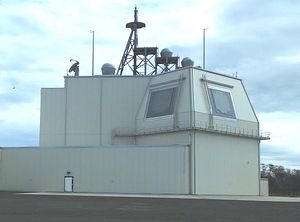Japan has selected a scaled-down version of the Lockheed Martin Long Range Discrimination Radar (LRDR) for its planned two Aegis Ashore batteries, the land-based variant of the Aegis combat system, in an upgrade of the country’s ballistic missile defense capabilities, according to a Japanese Ministry of Defense (MoD) official who spoke to Reuters on the condition of anonymity this week.
The two Aegis Ashore batteries, fitted with a new Lockheed Martin radar based on the LRDR system, are expected to strengthen Japanese defenses against China’s and North Korea’s growing and increasingly more sophisticated ballistic and cruise missile arsenals.
The government plans to deploy the two batteries by 2023 at an estimated cost of around $4 billion.
The Aegis Ashore sites will supplement Patriot batteries capable of engaging short- and medium-range ballistic missiles in their terminal phase and Aegis-equipped guided-missile destroyers, four of which are currently in service with the Japan Maritime Self-Defense Force (JMSDF).
According to the Japanese official, the MoD selected the LRDR-based radar over Raytheon’s SPY-6 due to lower lifecycle costs and its sophisticated target discrimination capabilities, which a Lockheed Martin official defined back in 2017 as the “ability to do precise, long-distance detection and characterization of ballistic missiles.”
Not much is publicly known about the LRDR. According to the Lockheed Martin website: “LRDR is a long range radar that will provide precision metric data to improve ballistic defense discrimination and replace existing sensors in the Ballistic Missile Defense System (BMDS).” The radar uses proven solid-state radar technologies with proven ballistic missile defense algorithms for target selection.
The procurement of the LRDR-based radar (perhaps a variant of Lockheed Martin’s SSR system) means that the Aegis Ashore sites would be able to fire their missiles at an extended range. For example, SM-3 Block IIA interceptors are estimated to have a maximum operational range of 2,500 km (1,350 miles). (The U.S. State Department approved a possible sale of SM-3s in January of this year.)
The missile “is designed to destroy short- to intermediate-range ballistic missile threats. The SM-3 has been successfully flight tested in February [2017] when it destroyed a medium-range ballistic missile target,” I reported previously. “However, the missile failed another intercept test in June [2017].” Another SM-3 missile test failed in January 31.
Japan’s Aegis Ashore batteries will also be armed with the supersonic SM-6 missile interceptor with an estimated range of over 180 miles (290 kilometers). “The missile was originally designed for anti-air warfare, anti-surface warfare missions,” I explained elsewhere. “Yet in 2015, the missile was modified for terminal ballistic missile defense to supplement U.S. Navy SM-3 ballistic missile interceptors deployed at land-based Aegis Ashore sites and Aegis-equipped warships.”
In order for a missile interceptor to hit an incoming ballistic missile, the Aegis combat system would have to start tracking the missile in its ascent phase and launch interceptors before it overflies the Aegis ashore site.
The MoD has so far not publicly confirmed the selection of the LRDR-based radar for its future Aegis Ashore batteries.































